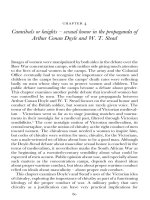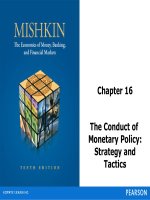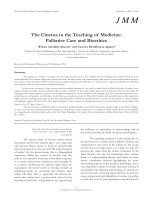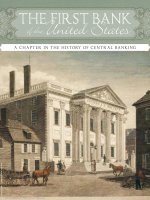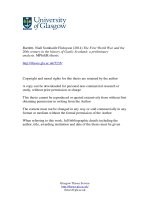Glasner studies in the history of monetary theory controversies and clarifications (2021)
Bạn đang xem bản rút gọn của tài liệu. Xem và tải ngay bản đầy đủ của tài liệu tại đây (7.14 MB, 521 trang )
PALGRAVE STUDIES IN THE HISTORY OF ECONOMIC THOUGHT
Studies in the History of
Monetary Theory
Controversies and Clarifications
David Glasner
Palgrave Studies in the History of Economic
Thought
Series Editors
Avi J. Cohen, Department of Economics, York University & University
of Toronto, Toronto, ON, Canada
G. C. Harcourt, School of Economics, University of New South Wales,
Sydney, NSW, Australia
Peter Kriesler, School of Economics, University of New South Wales,
Sydney, NSW, Australia
Jan Toporowski, Economics Department School of Oriental & African
Studies, University of London, London, UK
Palgrave Studies in the History of Economic Thought publishes contributions by leading scholars, illuminating key events, theories and individuals that have had a lasting impact on the development of modern-day
economics. The topics covered include the development of economies,
institutions and theories.
The series aims to highlight the academic importance of the history of
economic thought, linking it with wider discussions within economics and
society more generally. It contains a broad range of titles that illustrate
the breath of discussions – from influential economists and schools of
thought, through to historical and modern social trends and challenges
– within the discipline.
All books in the series undergo a single-blind peer review at both the
proposal and manuscript submission stages.
For further information on the series and to submit a proposal for
consideration, please contact the Wyndham Hacket Pain (Economics
Editor)
More information about this series at
/>
David Glasner
Studies in the History
of Monetary Theory
Controversies and Clarifications
David Glasner
Washington, DC, USA
ISSN 2662-6578
ISSN 2662-6586 (electronic)
Palgrave Studies in the History of Economic Thought
ISBN 978-3-030-83425-8
ISBN 978-3-030-83426-5 (eBook)
/>© The Editor(s) (if applicable) and The Author(s), under exclusive license to Springer
Nature Switzerland AG 2021
This work is subject to copyright. All rights are solely and exclusively licensed by the
Publisher, whether the whole or part of the material is concerned, specifically the rights
of translation, reprinting, reuse of illustrations, recitation, broadcasting, reproduction on
microfilms or in any other physical way, and transmission or information storage and
retrieval, electronic adaptation, computer software, or by similar or dissimilar methodology
now known or hereafter developed.
The use of general descriptive names, registered names, trademarks, service marks, etc.
in this publication does not imply, even in the absence of a specific statement, that such
names are exempt from the relevant protective laws and regulations and therefore free for
general use.
The publisher, the authors and the editors are safe to assume that the advice and information in this book are believed to be true and accurate at the date of publication. Neither
the publisher nor the authors or the editors give a warranty, expressed or implied, with
respect to the material contained herein or for any errors or omissions that may have been
made. The publisher remains neutral with regard to jurisdictional claims in published maps
and institutional affiliations.
Cover credit: ilbusca
This Palgrave Macmillan imprint is published by the registered company Springer Nature
Switzerland AG
The registered company address is: Gewerbestrasse 11, 6330 Cham, Switzerland
Preface
The studies in this volume, written over the course of four decades, are
the result of my continuing interest in monetary theory and its historical
development. The studies often reflect my own disappointment with that
development, especially the long ascendancy of the quantity theory of
money and the price-specie-flow mechanism as the lynchpins of monetary
theory and policy.
The prolific writings of Ralph Hawtrey from 1913 through the mid1930s provided a basis on which an improved monetary theory might
have been constructed. But, working largely in isolation as a civil servant,
with little opportunity, despite his early prominence, to educate younger
economists who might have carried on his unique approach to monetary
theory, his own contributions were gradually eclipsed during the Great
Depression, when they were most needed, falling into undeserved semioblivion.
Hawtrey’s friend, J. M. Keynes, whose early work was influenced
by, and shared much in common with, Hawtrey’s approach, eventually set the profession on a much different path from that followed
by Hawtrey. A couple of decades after Keynes published his great
work, Milton Friedman launched an anti-Keynesian Monetarist counterrevolution. In their monumental Monetary History of the United States,
Friedman and Anna Schwartz seemed to provide historical and empirical
support for his Monetarist doctrines with what seemed a more compelling
v
vi
PREFACE
monetary explanation of the Great Depression than either Keynesian or
non-Keynesian economists had ever before articulated.
But there was an earlier monetary theory of the Great Depression that
had been forgotten by the time the Monetary History was published: the
explanation that Hawtrey and Gustav Cassel had both developed independently in warning—fully a decade before the onset of the Great Depression—of the danger of a catastrophic deflation unless the likely resumption of the prewar gold standard was managed in a way that minimized
increases in the international monetary demand for gold.
The sad story of the collective amnesia suffered by the economics
profession concerning the Hawtrey-Cassel explanation of the Great
Depression is not widely known. Although our understanding of the
causes Great Depression was greatly enhanced over the past 30 years by
the work of Barry Eichengreen, Peter Temin, and others, the more recent
work merely confirms and expands upon the fundamental early insights of
Hawtrey and Cassel, and the immense contributions of those two great
economists remain unrecognized or underrated.
That is not the only sad story told in this volume. We are still watching
the latter story work itself out in real time, without knowing how, or
when, it ends. Following its 1980s collapse as a guide for policy and
a theoretical paradigm, Monetarism was superseded by a new paradigm
in which expectations are formed rationally, and all agents make microfounded optimal decisions. Yet again, the economics profession has, in
my view, taken the wrong path.
Perhaps I will have occasion in the future to spell out more fully than I
have in this volume the reasons for my dissatisfaction with the path taken
by modern macroeconomic theory. But I have begun telling that story
in my three final chapters about Hayek. Although his early work led him
to offer horrendous policy advice, it also endowed him with profound
insight, at least in the abstract, into the conditions for intertemporal
equilibrium and macroeconomic stability.
That profound insight, developed almost simultaneously with Hayek
by two young Swedish economists, Gunnar Myrdal and Erik Lindahl,
helped lead Hayek’s younger colleague at the London School of
Economics, J. R. Hicks, to develop the idea of temporary equilibrium as
an alternative to the pure Walrasian general-equilibrium approach, whose
underlying assumption of perfect foresight renders it unsuitable for the
analysis of involuntary unemployment and financial crises. And it is that
analysis, after all, which is what justifies the existence of macroeconomics.
PREFACE
vii
But neither Hayek nor Hicks was able to carry the temporary-equilibrium
approach forward as an analytical tool for monetary and macroeconomic
theorizing, which, instead, wandered into the dead-end known as the
neoclassical synthesis.
Enthralled by rational expectations, macroeconomists sought escape
from that dead-end by succumbing to the methodological imperatives of
axiomatic mathematical formalism, devoting themselves for 40 years to
a family of sterile micro-founded models that, obeying methodological
fiat, assume away the vexing problems of uncertainty and imperfect foresight that are, or should be, at the heart of any useful macroeconomic
theory. Modern macroeconomics has thus been reduced to a methodological approach by which it has been disabled from considering the
very problems that macroeconomists and monetary theorists ought to be
addressing.
Attentive readers of the essays in this volume will hardly conclude that I
am hostile to the theory and practice of neoclassical economics in which I
was trained at UCLA, and whose alien concepts have been instilled deeply
in my mind by a half-century of repeated and varied iteration. But the
version of neoclassical theory on which modern macroeconomics has been
built is a vulgar and reductive neoclassicism that is rightly disparaged and
mocked by its critics.
These pessimistic comments notwithstanding, I have not lost hope
that the following essays may provide some hints and suggestions about
finding alternative paths toward a more useful macroeconomics.
Washington, DC, USA
David Glasner
Acknowledgments
The studies that follow were written over the course of four decades, and
I fear that there are many deserving of thanks whose assistance I no longer
recall, and whom I therefore cannot mention, much less adequately thank.
Thanks to those whom I do remember must start with my parents,
Rabbi Juda and Deborah Glasner, Holocaust survivors who arrived in
the United States with my brother, Moses, in time for me to become
a natural-born citizen of the United States of America, thereby anchoring
the residence and eventual citizenship of my parents and my brother in
the United States. My parents raised their two sons lovingly, instilling in
us reverence for, and attachment to, the cherished traditional Judaism in
which we were raised and the liberal, democratic values of their adopted
country. They encouraged the pursuit of our scholarly ambitions, even
though those ambitions were not quite the ones that they would have
chosen for us.
My scholarly debts, of course, begin with my teachers at UCLA, especially Armen Alchian, Harold Demsetz, Jack Hirshleifer, Benjamin Klein,
Axel Leijonhufvud, and Earl Thompson. Only Klein, Leijonhufvud, and
Thompson taught me about monetary theory and macroeconomics, but,
at a deep level, my understanding of what economics is about and how it
should be done was enriched immeasurably by what I learned from all of
them. I also had the benefit of meeting, and briefly studying under, F. A.
Hayek when he visited the UCLA philosophy department in the 1968–
1969 academic year. Notwithstanding my criticism of some of his writings
ix
x
ACKNOWLEDGMENTS
and policy recommendations, his work, as will be evident to readers of this
volume, has been a continuing source of insight and inspiration for me.
In writing the studies in this volume, I have benefitted from comments,
suggestions, and criticisms from among others James Ahiakpor, Armen
Alchian, William Baumol, Mark Blaug, Meyer Burstein, Phillip Cagan,
Robert Clower, Patrick Deutscher, Robert Dimand, Malcolm Fisher,
June Flanders, Charles Goodhart, Harald Hagemann, Geoffrey Harcourt,
Benjamin Klein, David Laidler, Axel Leijonhufvud, Richard Lipsey, Perry
Mehrling, Donald Moggridge, Jürg Niehans, Denis O’Brien, Anna
Schwartz, George Selgin, Rajiv Sethi, Neil Skaggs, Matthew Smith, Scott
Sumner, Earl Thompson, Richard Trestrail, and Larry White. I deeply
regret being unable to mention the names of others who also provided
valuable assistance when I was writing these studies.
I was greatly impressed by the early papers of David Laidler on Thomas
Tooke and Adam Smith, and they have served as a model for me to
emulate. David has never disappointed me when I sought to draw on
his wisdom and his insight into economic theory and its history, which
he has always imparted to me with thoughtfulness and good humor. I am
deeply grateful for the benefit of his friendship and counsel.
A paper on the foundations of national-income theory by another great
Canadian economist, Richard Lipsey, also made a deep impression on me
when I read it as a graduate student. It was also one of the first papers I
read that discussed Ralph Hawtrey in detail. In recent years, after beginning my blog Uneasy Money, Dick and I began corresponding frequently,
and I have benefitted greatly from his insight and advice on diverse
topics, especially the Phillips Curve, monetary neutrality, and rational
expectations.
Chapter 6 in this volume was originally a paper presented at a
conference in Tokyo in 2011 commemorating the 200th anniversary of
David Ricardo’s first published work in economics. That conference was
conducted along with another conference on Ricardo which was attended
by Geoffrey Harcourt who presented a paper to a joint session of the
two conferences. It was my good fortune to meet Geoff for the first time
before his lecture, and we immediately took a liking to each other, finding
out to our surprise that, despite the differences in our upbringings and
our viewpoints on economics, we shared similar eastern European roots.
Though we have not seen each other since, we have stayed in frequent
touch, and I am honored by, and grateful for his friendship, as well as his
ACKNOWLEDGMENTS
xi
close reading of, and editorial and substantive comments on, several chapters in this volume. His encouragement and assistance were instrumental
in the publication of this volume.
In 2009, Scott Sumner began his blog The Money Illusion. He kindly
mentioned my book Free Banking and Monetary Reform and its proposal,
borrowed from Earl Thompson, to stabilize the average level of expected
wages. I had previously met Scott only once or twice at conferences that
we had both attended. His blog became an internet sensation and was
among the most important and popular of the many economics blogs that
sprang up after the 2008–2009 financial crisis. We began corresponding
regularly and I frequently submitted comments on his blog. Inspired and
encouraged by Scott, I launched my Uneasy Money blog, in July 2011,
which achieved modest success of its own, especially when noticed by
another blogger, named Paul Krugman. That success renewed my interest
in monetary theory, which had flagged in the preceding decade, and
eventually led me to write several blogposts that turned into chapters
or sections of chapters included in this volume. Chapter 8, in particular,
was written at Scott’s invitation for a joint conference that he and the
estimable George Selgin organized on behalf of the Mercatus Center and
the Cato Institute. I shall always be grateful to Scott for his friendship and
encouragement.
I owe special thanks to my co-authors, Ronald W. Batchelder and Paul
Zimmerman, for collaborating with me on three of the essays included
herein. I have learned much from our collaboration, and the papers are
now far better than they would have or could have been had I written
them alone. I very much look forward to collaborating with them again
on future projects.
Special thanks are also due to an old friend, Grace Goldblatt, for wise
advice on a problem that I was unprepared to address by myself. On short
notice, she graciously stepped in and helped me navigate a tricky situation
that required resolution before I could finish this project.
My daughters, Chaya and Shifra, have been the most precious gifts and
the greatest blessings that my wife and I have ever received. We thank
them for helping to keep us young and busy, for bringing their husbands,
Eytan Storfer and Yair Gemara, into our family, and making us proud
grandparents. I am also indebted to Yair for helping me reproduce the
diagrams in Chapters 2–4 of this volume.
Finally, and most important, my thanks and my heart go out to my
wife and dearest friend, Tovi. Without your love and support, patience
xii
ACKNOWLEDGMENTS
and good humor, in good times and not so good times, very little of what
follows could have been written. You raised our daughters to become the
wonderful and accomplished young women that they are today. Your life’s
work continues, but you have already accomplished so much. “May the
Lord reward your deeds, may you have full recompense from the Lord
God of Israel” (Ruth 2:12). I love you dearly.
I also want to thank Rachel Sangster, Wyndham Hacket Pain, Lavanaya
Devgun, Srishti Gupta, Shreenidhi Natrajan, and Zobaria Jidda of
Palgrave Macmillan for their thoughtful and capable assistance in developing the proposal for this book, and carrying it forward to a successful
conclusion. The task has not always been easy, but I hope that the end
result will be satisfying and worthwhile for us all.
Finally, I gratefully acknowledge permission to republish the following
studies in this volume.
Chapter 2, “A Reinterpretation of Classical Monetary Theory” was
originally published in The Southern Economic Journal, Vol: 52:1,
pp. 46–67 © 1985, Republished by permission. Southern Economic
Association.
Chapter 3, “On Some Classical Monetary Controversies” was originally published in History of Political Economy, Vol 21:2, pp. 201–
229. © 1989, Duke University Press. All rights reserved. Republished by permission. www.dukeupress.edu.
Chapter 4, “The Real-Bills Doctrine in the Light of the Law of
Reflux” was originally published in History of Political Economy,
Vol: 24:4, pp. 867–894. © 1992, Duke University Press. All rights
reserved. Republished by permission. www.dukeupress.edu.
Chapter 5, “Classical Monetary Theory and the Quantity Theory”
was originally published in History of Political Economy, Vol: 32:1,
pp. 39–59. © 2000, Duke University Press. All rights reserved.
Republished by permission. www.dukeupress.edu.
Chapter 6, “Monetary disequilibrium and the demand for money
in Ricardo and Thornton” was originally published in Ricardo on
money and finance: a bicentenary reappraisal, pp. 15–29. © 2013
[according to the front matter the copyright is held by the author].
Chapter 8, “Rules versus Discretion in Monetary Policy Historically
Considered” was originally published in The Journal of Macroeconomics Vol: 54:4a, pp. 24–41. © 2017, Elsevier. All rights reserved.
Republished by permission.
ACKNOWLEDGMENTS
xiii
Chapter 11, “Ralph George Hawtrey” was originally published in
The Elgar Companion to John Maynard Keynes, pp. 338–347 © 2019
R. Dimand and H. Hagemann. It appears in this volume under
the title “Hawtrey and Keynes.” All rights reserved. Republished by
permission.
Chapter 12, “Where Keynes Went Wrong” was originally published
in Encounter, December 1988.
Chapter 13, “Debt, Deflation, the Great Depression and the Gold
Standard” was originally published in Money and Banking: The
American Experience, pp. 277–310. © George Mason University
Press. All rights reserved. Republished by permission.
Chapter 16, “Hayek, Deflation, Gold and Nihilism” was originally
published in Hayek: A Collaborative Biography Part XIII: ‘Fascism’
and Liberalism in the (Austrian) Classical Tradition, pp. 161–192 ©
The editors and the authors.
Chapter 17, “Hayek, Hicks, Radner and Four Equilibrium Concepts:
Perfect Foresight, Sequential, Temporary and Rational Expectations” was originally published in The Review of Austrian Economics
© 2020, Springer. All rights reserved.
Praise for Studies in the History of
Monetary Theory
“Understanding the uses and limitations of monetary policy requires first
understanding how economists think about money, past, present and
future. That the history of monetary theory, like the history of economic
thought generally, has fallen out of fashion in academia is all the more
reason to value the important work of David Glasner and the insightful
essays collected in this book.”
—Barry Eichengreen, University of California, Berkeley, USA
“David Glasner has been pursuing fundamental questions in monetary
theory in a deep way for over thirty years. This collection represents the
distillation of his wisdom, and any economist interested in these issues will
learn a great deal by reading these pieces. They are deep in the theoretical
sense but practical as well.”
—Tyler Cowen, George Mason University, USA
“David Glasner challenges much conventional wisdom about monetary
history, and his essays are invariably provocative, well researched and
clearly written. They are a pleasure to read. They deserve serious attention
from anyone interested in how ideas about the monetary system have, and
still do, interact with its evolution and operation.”
—David Laidler, University of Western Ontario, Canada
xv
xvi
PRAISE FOR STUDIES IN THE HISTORY OF MONETARY THEORY
“David Glasner has pulled together a lifetime of erudite work on the
history of monetary thought in this collection of papers. It is divided into
two main blocks, the first part revisiting the UK classical monetary debates
of the early 19th century, and the second part primarily on the contribution of Hawtrey and Hayek to interwar monetary issues. All are well worth
reading, but I especially liked the emphasis on Hawtrey’s contribution.”
—Charles Goodhart, London School of Economics, UK
“This collection of essays is both an engaging excursion into the history
of monetary thought, and a powerful case for an approach to macroeconomics that allows for heterogeneity in beliefs and adjustments to disappointed expectations. It will be of value to students of modern macroeconomics who would like a clear-headed appraisal of the limitations of
textbook models, by someone who thinks with exceptional clarity about
these complex and contentious issues.”
—Rajiv Sethi, Barnard College, Columbia University, USA
“This book will surely give the history of economic thought a good name.
Its lucid and convincing analyses of the celebrated debates relating to
monetary theory from Hume through to Cairnes, and to the twentiethcentury contributions by Hawtrey, Keynes and Hayek render it ideal for
advanced courses. The author’s account of the influences governing his
intellectual development provides an interesting case-study of the informal
lines of communication at play in the academic context.”
—Samuel Hollander, University of Toronto, Canada
“This delightful book reviews, from a modern perspective, some classic
debates in monetary economics. Beyond their historical interest, these
debates still appear in contemporary discussions, even if dressed in
different clothes. Take the Real Bills Doctrine, but rewrite it in terms of
shadow banks: if non-conventional financial institutions lend only on the
security of real bills, can they create too much money? Anyone interested
in macroeconomics will benefit much from reading Glasner’s collection of
essays.”
—Jesus Fernandez-Villaverde, University of Pennsylvania, USA
“David Glasner is a well-known historian of monetary economics and
editor of the widely-read Business Cycles and Depressions: An Encyclopedia. In this inspiring collection, he focuses on controversies in classical
PRAISE FOR STUDIES IN THE HISTORY OF MONETARY THEORY
xvii
monetary theory and contributions by Keynes, Hayek and Glasner‘s real
hero, Ralph Hawtrey, who significantly advanced the analysis of monetary
factors in economic fluctuations. The underlying unity is Glasner’s development of the implications of the monetary approach to the balance of
payments and endogenous money.”
—Harald Hagemann, University of Hohenheim, Germany
“David Glasner’s book captures his lifetime exploration into the deeper
longstanding questions of monetary and macroeconomic theory, questions like Say’s Law, and the nature of macroeconomic equilibrium.
Unlike most theorists, David’s approach is to situate these questions
in historical context. So this book is much more than a collection of
carefully-crafted essays in the history of economic thought, though it
is that too. Strongly recommended to all readers interested in monetary
theory and macroeconomics.”
—Nicholas Rowe, University of Western Ontario, Canada
“David Glasner’s Essays in the History of Monetary Theory: Controversies
and Clarifications examines the long sweep of monetary economics from
the 18th to the 21st century in relation to changing monetary institutions.
Anyone who wishes to better understand how money worked in the past
and may work in the future will profit from reading Glasner’s lucid and
informative book.”
—Kevin Hoover, Duke University, USA
“David Glasner’s collection of papers, some published previously some
new, constitute together an impressive and comprehensive set of original
studies covering monetary and macro analysis from the mid-18th century
to the 20th. It is an admirable lifework, presenting a refined perspective
that will appeal to everyone interested in the history of human thinking
dedicated to the study of whole economies. Old and new controversies
come to life, elucidating why scholars reach different conclusions. Highly
recommended.”
—Arie Arnon, Ben Gurion University, Israel
xviii
PRAISE FOR STUDIES IN THE HISTORY OF MONETARY THEORY
“David Glasner provides a tour de force of the history of monetary
thought. Along the way, he reminds us that everything old is new again
when it comes to monetary theory.”
—David Beckworth, George Mason University, USA
“David Glasner’s studies into the history of monetary theory show
how certain classical macroeconomic principles, properly understood, can
clarify some of the macroeconomic debates that continue to divide the
profession. Glasner is particularly good at explaining how overlooked
thinkers such as Gustav Cassel, Ralph Hawtrey and Earl Thompson developed insights into the sources of business cycles that were in many ways
superior to the approaches developed by more famous theorists such as
Keynes and Friedman.”
—Scott Sumner, George Mason University, USA
“David Glasner’s Studies in the History of Monetary Theory: Controversies
and Clarifications is a tour de force through classical monetary theory and
policy from Hume and Smith, an examination of Say’s Law, and the implications of these controversies for the critical debates of the 20th century.
Glasner has an astute ability to provide clarity to critical debates on the
complicated subject of monetary theory and policy and macroeconomic
and economic performance through time. Highly recommended.”
—Peter Boetke, George Mason University, USA
“A very much needed and welcome collection of essays on monetary and
banking theories. David Glasner reminds us that there is much more to
economics that the Chicago School and its strawmen. This is a true work
of history of ideas, where explanations of current crises can be found in
three centuries of the study of money and banking. This volume is a must
read for anyone interested in money and banking.”
—Maria Pia Paganelli, Trinity University, USA
“David Glasner’s new book is a sensitive and erudite exposition and exploration of classical monetary theory, from Smith to Hume and their interpretations. It also excavates the work of Ralph Hawtrey, as well as the
less appreciated insights of John Maynard Keynes and Friedrich Hayek.
In doing so, it suggests a bold set of alternative starting points to study
monetary macroeconomics and macroeconomic episodes, and a promising
way to reverse the subject’s retrogression.”
—Arjun Jayadev, Azim Premji University, India
PRAISE FOR STUDIES IN THE HISTORY OF MONETARY THEORY
xix
“This book is the product of decades of work by Glasner, and it shows. It
reviews the thinking of major monetary economists, many of whom have
been wrongly overlooked, especially Hawtrey and Cassel who presented
an monetary interpretation of the Great Depression in contrast to Friedman’s US-centric explanation. Glasner’s book is a welcome addition to
the literature, which has something for anyone interested in monetary
economics, the history of economic thought, or the Great Depression.”
—Gabriel Mathy, American University, USA
“It was watching, during the Great Recession, macroeconomists of note
and reputation who knew none of the history of monetary economics
repeatedly make mistake after mistake—often at an infantile level—
because of their ignorance that made me realize how lucky I am to have
been able to read and learn from David Glasner.”
—Brad DeLong, University of California, Berkeley, USA
“David Glasner’s Essays in the History of Monetary Theory collects and
extends his scholarly, fascinating and readable work on classical monetary theory and on monetary interpretations of the Great Depression.
Everyone interested in the history of monetary economics and macroeconomics, especially international adjustment under the gold standard and
attempts to explain systemic coordination failure, should read this book.
Scholars in these fields will long refer to these articles and assign them to
their students.”
—Robert Dimand, Brock University, Canada
Contents
1
Introduction
1
Part I Classical Monetary Theory
2
A Reinterpretation of Classical Monetary Theory
21
3
On Some Classical Monetary Controversies
51
4
The Real-Bills Doctrine in the Light of the Law
of Reflux
85
5
Classical Monetary Theory and the Quantity Theory
113
6
Monetary Disequilibrium and the Demand for Money
in Ricardo and Thornton
135
The Humean and Smithian Traditions in Monetary
Theory
155
Rules Versus Discretion in Monetary Policy
Historically Contemplated
195
Say’s Law and the Classical Theory of Depressions
239
7
8
9
Part II
10
Hawtrey, Keynes, and Hayek
Hawtrey’s Good and Bad Trade: A Centenary
Retrospective
263
xxi
xxii
CONTENTS
11
Hawtrey and Keynes
297
12
Where Keynes Went Wrong
313
13
Debt, Deflation, the Great Depression and the Gold
Standard (with Ronald W. Batchelder)
331
Pre-Keynesian Monetary Theories of the Great
Depression: Whatever Happened to Hawtrey
and Cassel? (with Ronald W. Batchelder)
367
The Sraffa-Hayek Debate on the Natural Rate
of Interest (with Paul Zimmerman)
403
16
Hayek, Deflation, Gold and Nihilism
429
17
Hayek, Hicks, Radner, and Four Equilibrium
Concepts: Intertemporal, Sequential, Temporary,
and Rational-Expectations
457
14
15
Index
489
About the Authors
David Glasner received his Ph.D. in economics from UCLA. He is the
author of Free Banking and Monetary Reform and editor of Business Cycles
and Depressions: An Encyclopedia.
Ronald W. Batchelder is Professor of economics at Pepperdine University. He has previously taught at Texas A&M, Tulane University, and
UCLA. His research in applied economic theory, international financial
institutions and the economic analysis of legal institutions has appeared
in the American Economic Review, Public Choice, and Explorations in
Economic History.
Paul R. Zimmerman received his doctorate from Florida State University. His research has appeared in the American Economic Review, Journal
of Law and Economics, Journal of Economic Behavior and Organization,
Southern Economic Journal, and other journals.
xxiii
List of Figures
Fig. 2.1
Fig. 2.2
Fig. 2.3
Fig. 3.1
Fig. 4.1
Fig. 4.2
Price-level determination under the gold standard
Effect of increased demand for money in a small open
economy
Effect of increased demand for money in a large open
economy
Price-level determination under the gold standard
Smith’s model of equilibrium for an individual bank
Fullarton’s model of equilibrium for an individual bank
29
31
33
54
89
99
xxv
List of Tables
Table 13.1
Table 14.1
The restoration sequence of the international gold
standard (1919–1929)
Gold Reserves in US, France, and the world (June
1928–December 1931)
343
394
xxvii
CHAPTER 1
Introduction
All of the studies in this volume, even the most recent one, are rooted
in ideas that first entered my mind in what Joseph Schumpeter called the
holy third decade of fertility in the life of a scientist, most of which I spent
as a student (undergraduate and graduate) at UCLA where my interest in
economics was kindled during the heyday of the storied UCLA economics
department.
The principal recurring ideas in these studies are the following:
1. The standard neoclassical models of economics textbooks typically
assume full information and perfect competition. But these assumptions are, or ought to be, just the starting point, not the end, of
analysis. Recognizing when and why these assumptions need to
be relaxed and what empirical implications follow from relaxing
those assumptions is how economists gain practical insight into, and
understanding of, complex economic phenomena.
2. Since the late eighteenth or early nineteenth century, much, if
not most, of the financial instruments actually used as media of
exchange (money) have been produced by private financial institutions (usually commercial banks); the amount of money that is
privately produced is governed by the revenue generated and the
cost incurred by creating money.
© The Author(s), under exclusive license to Springer Nature
Switzerland AG 2021
D. Glasner, Studies in the History of Monetary Theory,
Palgrave Studies in the History of Economic Thought,
/>
1
2
D. GLASNER
3. The standard textbook model of international monetary adjustment
under the gold standard (or any fixed exchange rate system), the
price-specie-flow mechanism, introduced by David Hume mischaracterized the adjustment mechanism by overlooking that the prices
of tradable goods in any country are constrained by the prices of
those tradable goods in other countries. That arbitrage constraint
on the prices of tradable goods in any country prevents price levels
in different currency areas from deviating, regardless of local changes
in the quantity of money, from a common international level.
4. The Great Depression was caused by a rapid appreciation of gold
resulting from the increasing monetary demand for gold occasioned
by the restoration of the international gold standard in the 1920s
after the demonetization of gold in World War I.
5. If the expected rate of deflation exceeds the real rate of interest,
real-asset prices crash and economies collapse.
6. The primary concern of macroeconomics as a field of economics is
to explain systemic failures of coordination that lead to significant
lapses from full employment.
7. Lapses from full employment result from substantial and widespread
disappointment of agents’ expectations of future prices.
8. The only—or at least the best—systematic analytical approach to
the study of such lapses is the temporary-equilibrium approach
introduced by Hicks (1939).
The first idea was instilled by the intellectual leader of the UCLA
economics department, Armen Alchian, whose output of publications,
though not exceptional in quantity, was extraordinary in quality and
profundity, asking, and at least suggesting answers to, fundamental questions in economics. Not the least important of those publications was the
textbook, University Economics, coauthored with his colleague William
Allen, and its posthumous sequel Universal Economics. It was a book
devoted to teaching students the underlying intuition and logic of
economic theory, not simply as a system of formal models, but as a way of
thinking, a way of thinking enabling one to apply that intuition and logic
flexibly in thinking through the implications of adjusting the underlying
assumptions of standard neoclassical models.

